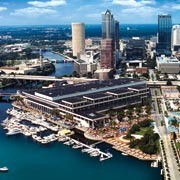"Go West!” may have been a familiar refrain during the country’s pioneer days, but in Florida it refers to the Gulf Coast, a sloping crescent of white-sand beaches and warm, blue-green waters that always feel like summer, and are accented each evening by glimmers of orange and red as the sun sinks into the horizon.
Right at the midpoint on Florida’s Gulf side is a notch in the coastline known as Tampa Bay, a magnificent expanse of water that divides the city of Tampa from the peninsula housing St. Petersburg, Clearwater and a host of beachside communities that stretch northward to Tarpon Springs, a harbor town built by Greek immigrants and the sponge-diving industry that today is probably the closest thing to Greece you’ll find in the New World.
“Sponge diving dates back to the time of Alexander the Great,” declares town patriarch, fleet captain and worldwide distributor of the natural sponge, George Billiris, whose family was among a few hundred who came over from Greece to dive for sponges in the late 1800s and early 1900s. The trade was so successful that the Great Depression and the privations of World War II had no effect on thriving Tarpon Springs, Billiris says.
However, a blight that began in 1946 destroyed the sponge beds, and the industry didn’t fully recover until the 1970s, when the Aegean Sea experienced a blight of its own. In between, while many families returned to Greece, the Billirises stayed on in Tarpon Springs and turned to tourism for their livelihood, using the sponge boats to take visitors on Gulf excursions and running local gift shops and restaurants.
Still, “tourism was a byproduct of what we do,” Billiris says, and once the sponge beds rebounded, the family went back to harvesting sponges, using the traditional Skafandro suit—a diving suit with an air hose—that allowed them to reach deeper waters. The day’s catch was then brought back to one of the state’s last working, commercial waterfronts, which teems with activity to this day.
“You can come down at 11-12 at night and see the sponge boats that have just come in with their catches, and it’s like a promenade,” Billiris says. “You just stroll the docks, and you’ve got restaurants and gift shops all around... and you see a bunch of old Greek guys screaming and hollering at each other about a soccer game. It’s like being in Europe.”
Except that you’re within minutes of prize-winning beaches, award-winning museums—including the Salvador Dali Museum and the acclaimed Museum of Science and Industry (MOSI)—and a winning combination of attractions, dining, ecotouring, and basically anything fun that involves saltwater and a boat.
Whether you escape to a controlled environment like Busch Gardens—where the new Jungala Congo area will open in spring 2008—or take a break from civilization via canoe venture or remote beach hike, there’s a natural feel to Tampa Bay that lets you know you’re in for an authentic experience wrapped up in a tropical getaway.
“Everything here is for real,” Billiris says of his beloved Tarpon Springs. “None of this stuff was put together for tourism, but because of it, we have a million people a year.”






